service indicator Lancia Flavia 2012 Owner handbook (in English)
[x] Cancel search | Manufacturer: LANCIA, Model Year: 2012, Model line: Flavia, Model: Lancia Flavia 2012Pages: 233, PDF Size: 2.61 MB
Page 81 of 233
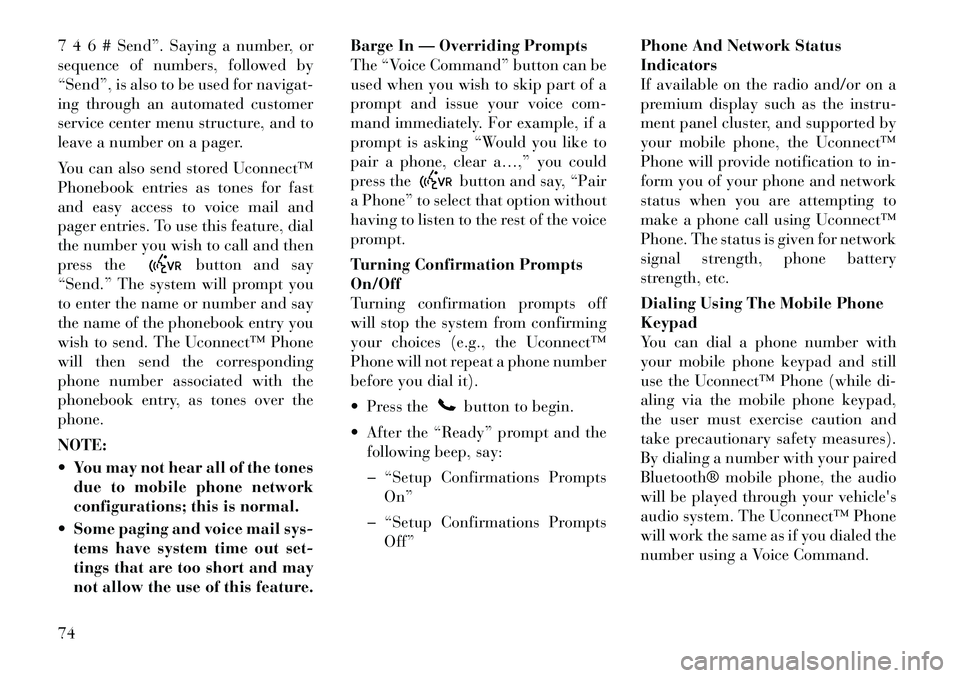
7 4 6 # Send”. Saying a number, or
sequence of numbers, followed by
“Send”, is also to be used for navigat-
ing through an automated customer
service center menu structure, and to
leave a number on a pager.
You can also send stored Uconnect™
Phonebook entries as tones for fast
and easy access to voice mail and
pager entries. To use this feature, dial
the number you wish to call and then
press the
button and say
“Send.” The system will prompt you
to enter the name or number and say
the name of the phonebook entry you
wish to send. The Uconnect™ Phone
will then send the corresponding
phone number associated with the
phonebook entry, as tones over the
phone.
NOTE:
You may not hear all of the tones due to mobile phone network
configurations; this is normal.
Some paging and voice mail sys- tems have system time out set-
tings that are too short and may
not allow the use of this feature. Barge In — Overriding Prompts
The “Voice Command” button can be
used when you wish to skip part of a
prompt and issue your voice com-
mand immediately. For example, if a
prompt is asking “Would you like to
pair a phone, clear a…,” you could
press the
button and say, “Pair
a Phone” to select that option without
having to listen to the rest of the voice
prompt.
Turning Confirmation Prompts
On/Off
Turning confirmation prompts off
will stop the system from confirming
your choices (e.g., the Uconnect™
Phone will not repeat a phone number
before you dial it).
Press thebutton to begin.
After the “Ready” prompt and the following beep, say:
� “Setup Confirmations Prompts On”
� “Setup Confirmations Prompts Off” Phone And Network Status
Indicators
If available on the radio and/or on a
premium display such as the
instru-
ment panel cluster, and supported by
your mobile phone, the Uconnect™
Phone will provide notification to in-
form you of your phone and network
status when you are attempting to
make a phone call using Uconnect™
Phone. The status is given for network
signal strength, phone battery
strength, etc.
Dialing Using The Mobile Phone
Keypad
You can dial a phone number with
your mobile phone keypad and still
use the Uconnect™ Phone (while di-
aling via the mobile phone keypad,
the user must exercise caution and
take precautionary safety measures).
By dialing a number with your paired
Bluetooth® mobile phone, the audio
will be played through your vehicle's
audio system. The Uconnect™ Phone
will work the same as if you dialed the
number using a Voice Command.
74
Page 118 of 233
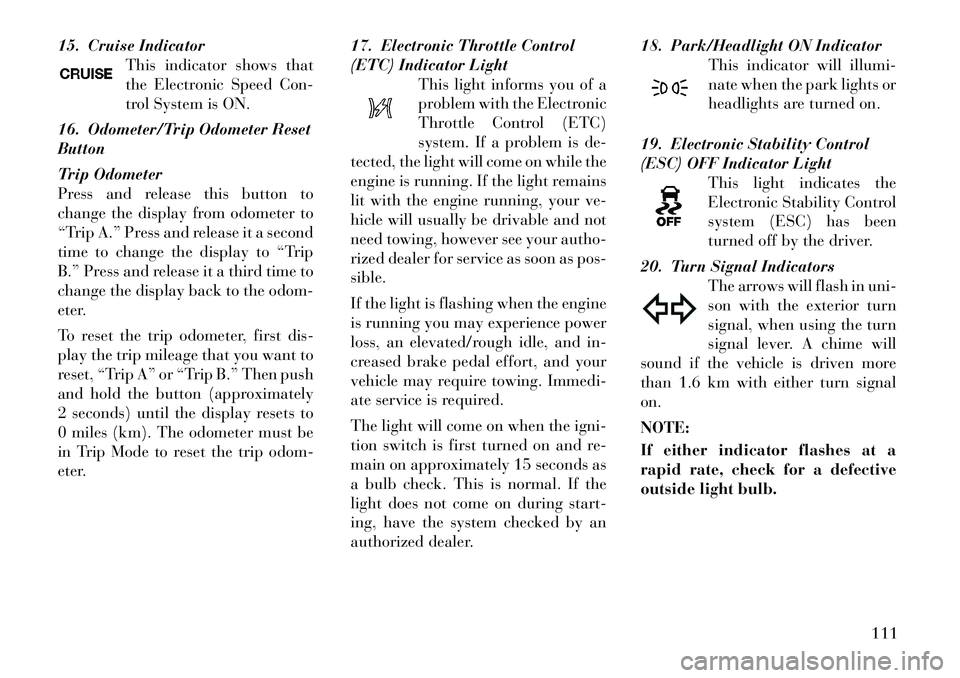
15. Cruise IndicatorThis indicator shows that
the Electronic Speed Con-
trol System is ON.
16. Odometer/Trip Odometer Reset
Button
Trip Odometer
Press and release this button to
change the display from odometer to
“Trip A.” Press and release it a second
time to change the display to “Trip
B.” Press and release it a third time to
change the display back to the odom-
eter.
To reset the trip odometer, first dis-
play the trip mileage that you want to
reset, “Trip A” or “Trip B.” Then push
and hold the button (approximately
2 seconds) until the display resets to
0 miles (km). The odometer must be
in Trip Mode to reset the trip odom-
eter. 17. Electronic Throttle Control
(ETC) Indicator Light
This light informs you of a
problem with the Electronic
Throttle Control (ETC)
system. If a problem is de-
tected, the light will come on while the
engine is running. If the light remains
lit with the engine running, your ve-
hicle will usually be drivable and not
need towing, however see your autho-
rized dealer for service as soon as pos-
sible.
If the light is flashing when the engine
is running you may experience power
loss, an elevated/rough idle, and in-
creased brake pedal effort, and your
vehicle may require towing. Immedi-
ate service is required.
The light will come on when the igni-
tion switch is first turned on and re-
main on approximately 15 seconds as
a bulb check. This is normal. If the
light does not come on during start-
ing, have the system checked by an
authorized dealer. 18. Park/Headlight ON Indicator
This indicator will illumi-
nate when the park lights or
headlights are turned on.
19. Electronic Stability Control
(ESC) OFF Indicator Light This light indicates the
Electronic Stability Control
system (ESC) has been
turned off by the driver.
20. Turn Signal Indicators The arrows will flash in uni-
son with the exterior turn
signal, when using the turn
signal lever. A chime will
sound if the vehicle is driven more
than 1.6 km with either turn signal
on.
NOTE:
If either indicator flashes at a
rapid rate, check for a defective
outside light bulb.
111
Page 119 of 233
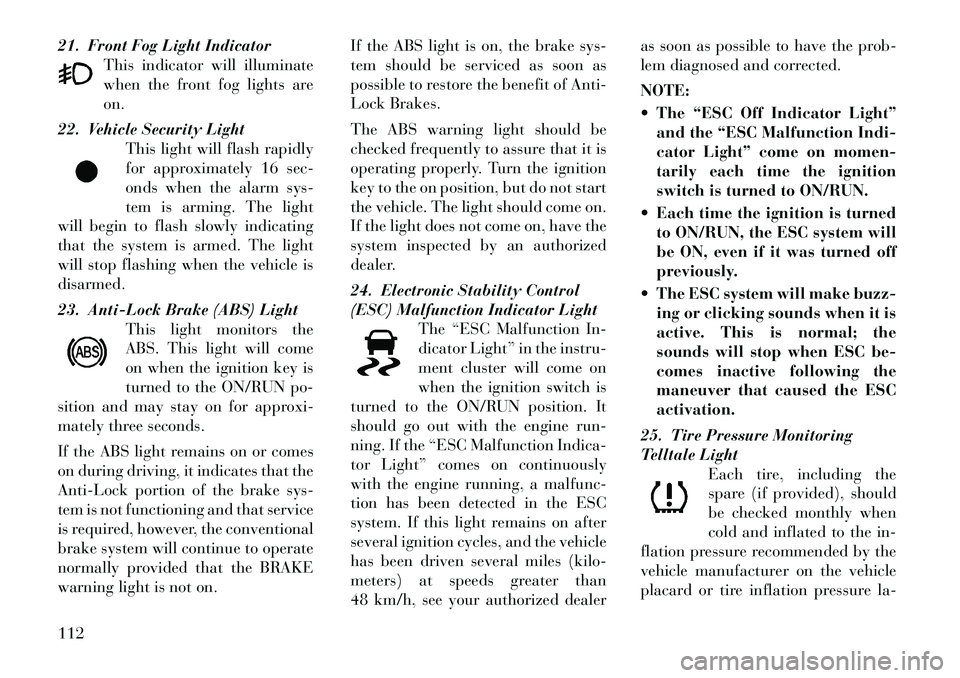
21. Front Fog Light IndicatorThis indicator will illuminate
when the front fog lights are
on.
22. Vehicle Security Light This light will flash rapidly
for approximately 16 sec-
onds when the alarm sys-
tem is arming. The light
will begin to flash slowly indicating
that the system is armed. The light
will stop flashing when the vehicle is
disarmed.
23. Anti-Lock Brake (ABS) Light This light monitors the
ABS. This light will come
on when the ignition key is
turned to the ON/RUN po-
sition and may stay on for approxi-
mately three seconds.
If the ABS light remains on or comes
on during driving, it indicates that the
Anti-Lock portion of the brake sys-
tem is not functioning and that service
is required, however, the conventional
brake system will continue to operate
normally provided that the BRAKE
warning light is not on. If the ABS light is on, the brake sys-
tem should be serviced as soon as
possible to restore the benefit of Anti-
Lock Brakes.
The ABS warning light should be
checked frequently to assure that it is
operating properly. Turn the ignition
key to the on position, but do not start
the vehicle. The light should come on.
If the light does not come on, have the
system inspected by an authorized
dealer.
24. Electronic Stability Control
(ESC) Malfunction Indicator Light
The “ESC Malfunction In-
dicator Light” in the instru-
ment cluster will come on
when the ignition switch is
turned to the ON/RUN position. It
should go out with the engine run-
ning. If the “ESC Malfunction Indica-
tor Light” comes on continuously
with the engine running, a malfunc-
tion has been detected in the ESC
system. If this light remains on after
several ignition cycles, and the vehicle
has been driven several miles (kilo-
meters) at speeds greater than
48 km/h, see your authorized dealer as soon as possible to have the prob-
lem diagnosed and corrected.
NOTE:
The “ESC Off Indicator Light”
and the “ESC Malfunction Indi-
cator Light” come on momen-
tarily each time the ignition
switch is turned to ON/RUN.
Each time the ignition is turned to ON/RUN, the ESC system will
be ON, even if it was turned off
previously.
The ESC system will make buzz- ing or clicking sounds when it is
active. This is normal; the
sounds will stop when ESC be-
comes inactive following the
maneuver that caused the ESC
activation.
25. Tire Pressure Monitoring
Telltale Light Each tire, including the
spare (if provided), should
be checked monthly when
cold and inflated to the in-
flation pressure recommended by the
vehicle manufacturer on the vehicle
placard or tire inflation pressure la-112
Page 121 of 233
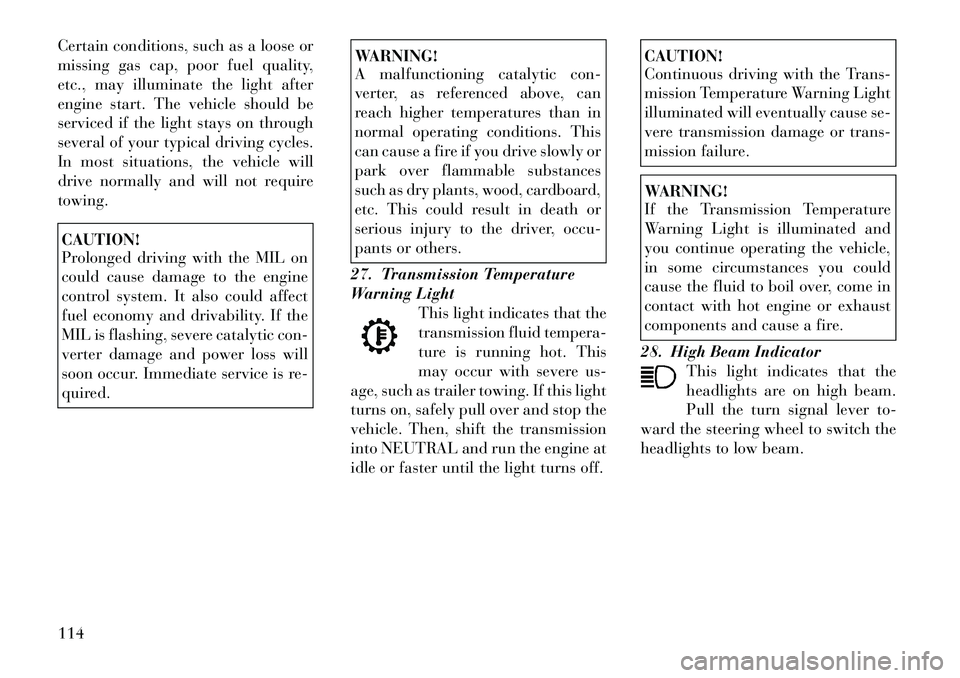
Certain conditions, such as a loose or
missing gas cap, poor fuel quality,
etc., may illuminate the light after
engine start. The vehicle should be
serviced if the light stays on through
several of your typical driving cycles.
In most situations, the vehicle will
drive normally and will not require
towing.CAUTION!
Prolonged driving with the MIL on
could cause damage to the engine
control system. It also could affect
fuel economy and drivability. If the
MIL is flashing, severe catalytic con-
verter damage and power loss will
soon occur. Immediate service is re-
quired.
WARNING!
A malfunctioning catalytic con-
verter, as referenced above, can
reach higher temperatures than in
normal operating conditions. This
can cause a fire if you drive slowly or
park over flammable substances
such as dry plants, wood, cardboard,
etc. This could result in death or
serious injury to the driver, occu-
pants or others.
27. Transmission Temperature
Warning Light This light indicates that the
transmission fluid tempera-
ture is running hot. This
may occur with severe us-
age, such as trailer towing. If this light
turns on, safely pull over and stop the
vehicle. Then, shift the transmission
into NEUTRAL and run the engine at
idle or faster until the light turns off.
CAUTION!
Continuous driving with the Trans-
mission Temperature Warning Light
illuminated will eventually cause se-
vere transmission damage or trans-
mission failure.WARNING!
If the Transmission Temperature
Warning Light is illuminated and
you continue operating the vehicle,
in some circumstances you could
cause the fluid to boil over, come in
contact with hot engine or exhaust
components and cause a fire.
28. High Beam Indicator This light indicates that the
headlights are on high beam.
Pull the turn signal lever to-
ward the steering wheel to switch the
headlights to low beam.
114
Page 147 of 233

mode (refer to “AutoStick®” in
“Starting And Operating” for further
information) to select a lower gear.
Under these conditions, using a lower
gear will improve performance and
extend transmission life by reducing
excessive shifting and heat buildup.
During cold temperatures, transmis-
sion operation may be modified de-
pending on engine and transmission
temperature as well as vehicle speed.
This feature improves warm up time
of the engine and transmission to
achieve maximum efficiency. Engage-
ment of the torque converter clutch is
inhibited until the transmission fluid
is warm (refer to the “Note” under
“Torque Converter Clutch” in this
section). During extremely cold tem-
peratures (27°C or below), operation
may briefly be limited to third gear
only. Normal operation will resume
once the transmission temperature
has risen to a suitable level.
Transmission Limp Home Mode
Transmission function is monitored
electronically for abnormal condi-
tions. If a condition is detected that
could result in transmission damage,Transmission Limp Home Mode is ac-
tivated. In this mode, the transmis-
sion remains in third gear regardless
of which forward gear is selected.
PARK, REVERSE, and NEUTRAL
will continue to operate. The Mal-
function Indicator Light (MIL) may
be illuminated. Limp Home Mode al-
lows the vehicle to be driven to an
authorized dealer for service without
damaging the transmission.
In the event of a momentary problem,
the transmission can be reset to regain
all forward gears by performing the
following steps:
1. Stop the vehicle.
2. Shift the transmission into PARK.
3. Turn the ignition switch to the
LOCK/OFF position.
4. Wait approximately 10 seconds.
5. Restart the engine.
6. Shift into the desired gear range. If
the problem is no longer detected, the
transmission will return to normal op-
eration.
NOTE:
Even if the transmission can be
reset, we recommend that you visit
an authorized dealer at your earli-
est possible convenience. Your au-
thorized dealer has diagnostic
equipment to determine if the
problem could recur.
If the transmission cannot be reset,
authorized dealer service is required.
Overdrive Operation
The automatic transmission includes
an electronically controlled Overdrive
(sixth gear). The transmission will
automatically shift into the Overdrive
gear if the following conditions are
present:
the shift lever is in the DRIVE po-
sition,
the transmission fluid has reached an adequate temperature,
the engine coolant has reached an adequate temperature,
vehicle speed is sufficiently high, and
the driver is not heavily pressing the accelerator.
140
Page 160 of 233

Cuts and punctures in radial tires are
repairable only in the tread area be-
cause of sidewall flexing. Consult
your authorized tire dealer for radial
tire repairs.
TIRE SPINNING
When stuck in mud, sand, snow, or icy
conditions, do not spin yourvehicle's
wheels faster than 48 km/h or for
longer than 30 seconds continuously
without stopping.
Refer to “Freeing A Stuck Vehicle” in
“What To Do In Emergencies” for fur -
ther information.WARNING!
Fast spinning tires can be danger-
ous. Forces generated by excessive
wheel speeds may cause tire damage
or failure. A tire could explode and
injure someone. Do not spin your
vehicle's wheels faster than 48 km/h
or for more than 30 seconds con-
tinuously when you are stuck, and
do not let anyone near a spinning
wheel, no matter what the speed. TREAD WEAR
INDICATORS
Tread wear indicators are in the origi-
nal equipment tires to help you in
determining when your tires should
be replaced.
These indicators are molded into the
bottom of the tread grooves. They will
appear as bands when the tread depth
becomes 2 mm. When the tread is
worn to the tread wear indicators, the
tire should be replaced.
LIFE OF TIRE
The service life of a tire is dependent
upon varying factors including but
not limited to:
Driving style
Tire pressure
Distance driven
WARNING!
Tires and spare tire should be re-
placed after six years, regardless of
the remaining tread. Failure to fol-
low this warning can result in sud-
den tire failure. You could lose con-
trol and have a collision resulting in
serious injury or death.
Keep dismounted tires in a cool, dry
place with as little exposure to light as
possible. Protect tires from contact
with oil, grease, and gasoline.
1 — Worn Tire
2 — New Tire
153
Page 189 of 233

ONBOARD DIAGNOSTIC
SYSTEM — OBD II
Your vehicle is equipped with a so-
phisticated onboard diagnostic sys-
tem called OBD II. This system moni-
tors the performance of the emissions,
engine, and automatic transmission
control systems. When these systems
are operating properly, your vehicle
will provide excellent performance
and fuel economy, as well as engine
emissions well within current govern-
ment regulations.
If any of these systems require service,
the OBD II system will turn on the
“Malfunction Indicator Light.” It will
also store diagnostic codes and other
information to assist your service
technician in making repairs. Al-
though your vehicle will usually be
drivable and not need towing, see
your dealer for service as soon as pos-
sible.
CAUTION!
Prolonged driving with the “Mal-function Indicator Light” on
could cause further damage to the
emission control system. It could
also affect fuel economy and
driveability. The vehicle must be
serviced before any emissions
tests can be performed.
If the “Malfunction Indicator
Light” is flashing while the engine
is running, severe catalytic con-
verter damage and power loss will
soon occur. Immediate service is
required.
REPLACEMENT PARTS
Use of genuine parts for normal/
scheduled maintenance and repairs is
highly recommended to ensure the de-
signed performance.
Damage or failures caused by the use
of parts which are not quality-
equivalent to genuine parts for main-
tenance and repairs will not be cov-
ered by the manufacturer’s warranty. MAINTENANCE
PROCEDURES
The pages that follow contain the
re-
quired maintenance services deter-
mined by the engineers who designed
your vehicle.
Besides those maintenance items
specified in the fixed maintenance
schedule, there are other components
which may require servicing or re-
placement in the future.
CAUTION!
Failure to properly maintain your vehicle or perform repairs and
service when necessary could re-
sult in more costly repairs, dam-
age to other components or nega-
tively impact vehicle
performance. Immediately have
potential malfunctions examined
by an authorized dealership or
qualified repair center.
(Continued)
182
Page 210 of 233
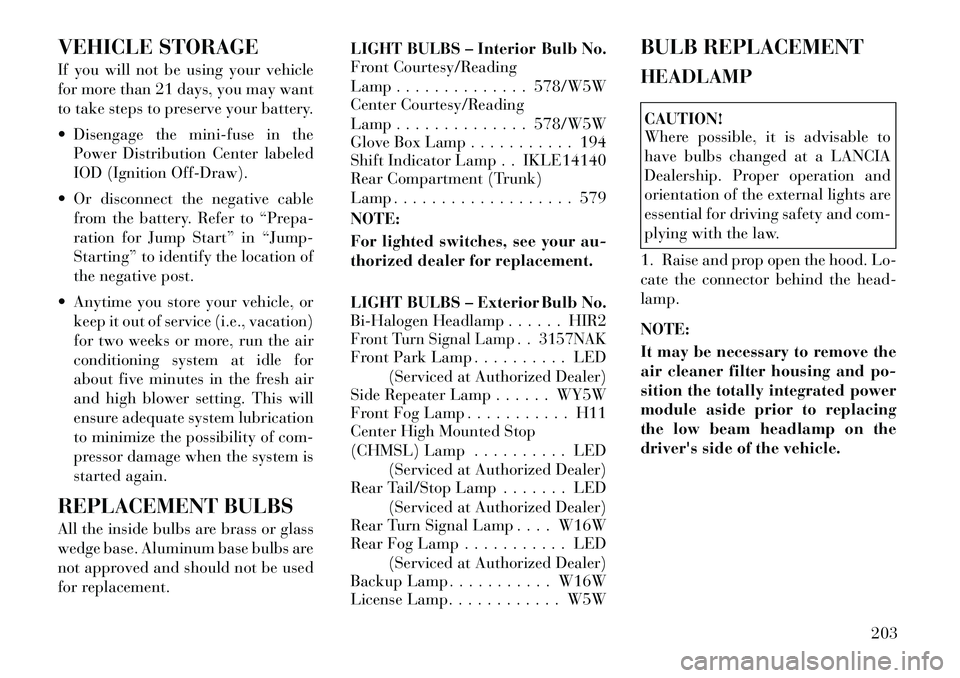
VEHICLE STORAGE
If you will not be using your vehicle
for more than 21 days, you may want
to take steps to preserve your battery.
Disengage the mini-fuse in thePower Distribution Center labeled
IOD (Ignition Off-Draw).
Or disconnect the negative cable from the battery. Refer to “Prepa-
ration for Jump Start” in “Jump-
Starting” to identify the location of
the negative post.
Anytime you store your vehicle, or keep it out of service (i.e., vacation)
for two weeks or more, run the air
conditioning system at idle for
about five minutes in the fresh air
and high blower setting. This will
ensure adequate system lubrication
to minimize the possibility of com-
pressor damage when the system is
started again.
REPLACEMENT BULBS
All the inside bulbs are brass or glass
wedge base. Aluminum base bulbs are
not approved and should not be used
for replacement. LIGHT BULBS – Interior Bulb No.
Front Courtesy/Reading
Lamp . . . . . . . . . . . . . . 578/W5W
Center Courtesy/Reading
Lamp . . . . . . . . . . . . . . 578/W5W
Glove Box Lamp . . . . . . . . . . . 194
Shift Indicator Lamp . . IKLE14140
Rear Compartment (Trunk)
Lamp . . . . . . . . . . . . . . . . . . . 579
NOTE:
For lighted switches, see your au-
thorized dealer for replacement.
LIGHT BULBS – Exterior Bulb No.
Bi-Halogen Headlamp . . . . . . HIR2
Front Turn Signal Lamp . . 3157NAKFront Park Lamp . . . . . . . . . . LED
(Serviced at Authorized Dealer)
Side Repeater Lamp . . . . . . WY5W
Front Fog Lamp . . . . . . . . . . . H11
Center High Mounted Stop
(CHMSL) Lamp . . . . . . . . . . LED
(Serviced at Authorized Dealer)
Rear Tail/Stop Lamp . . . . . . . LED
(Serviced at Authorized Dealer)
Rear Turn Signal Lamp . . . . W16W
Rear Fog Lamp . . . . . . . . . . . LED
(Serviced at Authorized Dealer)
Backup Lamp . . . . . . . . . . . W16W
License Lamp. . . . . . . . . . . . W5W BULB REPLACEMENT
HEADLAMP
CAUTION!
Where possible, it is advisable to
have bulbs changed at a LANCIA
Dealership. Proper operation and
orientation of the external lights are
essential for driving safety and com-
plying with the law.
1. Raise and prop open the hood. Lo-
cate the connector behind the head-
lamp.
NOTE:
It may be necessary to remove the
air cleaner filter housing and po-
sition the totally integrated power
module aside prior to replacing
the low beam headlamp on the
driver's side of the vehicle.
203
Page 219 of 233
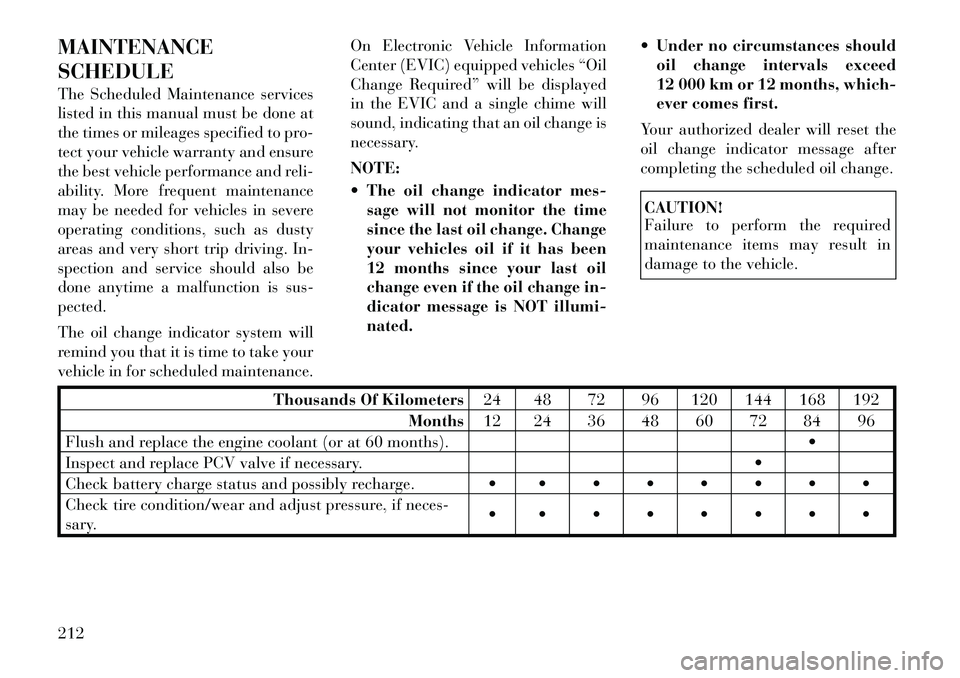
MAINTENANCE
SCHEDULE
The Scheduled Maintenance services
listed in this manual must be done at
the times or mileages specified to pro-
tect your vehicle warranty and ensure
the best vehicle performance and reli-
ability. More frequent maintenance
may be needed for vehicles in severe
operating conditions, such as dusty
areas and very short trip driving. In-
spection and service should also be
done anytime a malfunction is sus-
pected.
The oil change indicator system will
remind you that it is time to take your
vehicle in for scheduled maintenance.On Electronic Vehicle Information
Center (EVIC) equipped vehicles “Oil
Change Required” will be displayed
in the EVIC and a single chime will
sound, indicating that an oil change is
necessary.
NOTE:
The oil change indicator mes-
sage will not monitor the time
since the last oil change. Change
your vehicles oil if it has been
12 months since your last oil
change even if the oil change in-
dicator message is NOT illumi-
nated. Under no circumstances should
oil change intervals exceed
12 000 km or 12 months, which-
ever comes first.
Your authorized dealer will reset the
oil change indicator message after
completing the scheduled oil change.
CAUTION!
Failure to perform the required
maintenance items may result in
damage to the vehicle.
Thousands Of Kilometers 24 48 72 96 120 144 168 192
Months 12 24 36 48 60 72 84 96
Flush and replace the engine coolant (or at 60 months).
Inspect and replace PCV valve if necessary.
Check battery charge status and possibly recharge.
Check tire condition/wear and adjust pressure, if neces-
sary.
212
Page 230 of 233
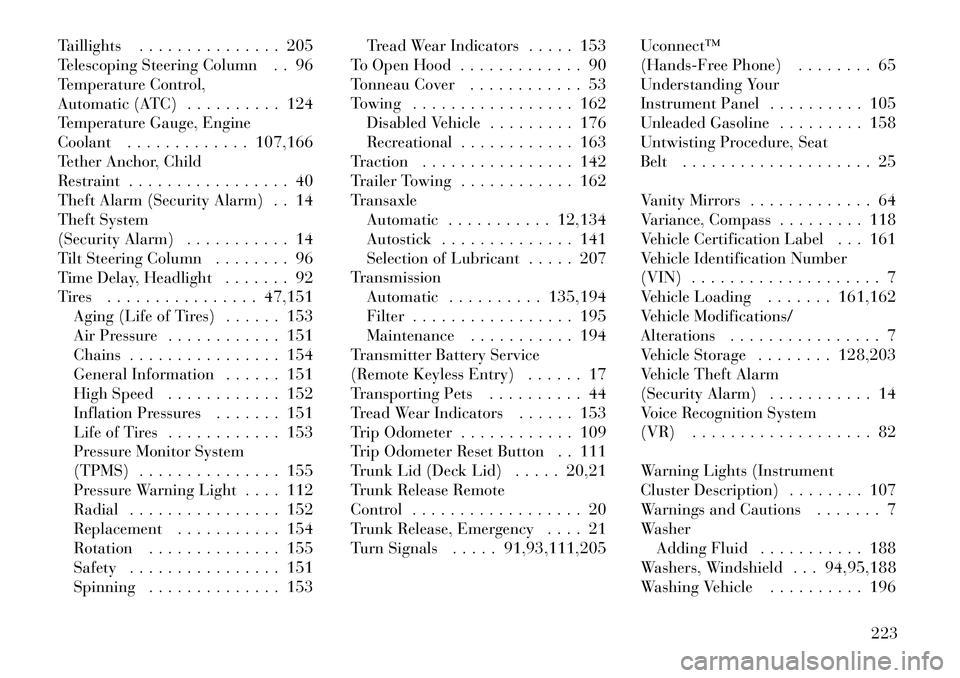
Taillights . . . . . . . . . . . . . . . 205
Telescoping Steering Column . . 96
Temperature Control,
Automatic (ATC) . . . . . . . . . . 124
Temperature Gauge, Engine
Coolant . . . . . . . . . . . . . 107,166
Tether Anchor, Child
Restraint . . . . . . . . . . . . . . . . . 40
Theft Alarm (Security Alarm) . . 14
Theft System
(Security Alarm) . . . . . . . . . . . 14
Tilt Steering Column . . . . . . . . 96
Time Delay, Headlight . . . . . . . 92
Tires . . . . . . . . . . . . . . . . 47,151Aging (Life of Tires) . . . . . . 153
Air Pressure . . . . . . . . . . . . 151
Chains . . . . . . . . . . . . . . . . 154
General Information . . . . . . 151
High Speed . . . . . . . . . . . . 152
Inflation Pressures . . . . . . . 151
Life of Tires . . . . . . . . . . . . 153
Pressure Monitor System
(TPMS) . . . . . . . . . . . . . . . 155
Pressure Warning Light . . . . 112
Radial . . . . . . . . . . . . . . . . 152
Replacement . . . . . . . . . . . 154
Rotation . . . . . . . . . . . . . . 155
Safety . . . . . . . . . . . . . . . . 151
Spinning . . . . . . . . . . . . . . 153 Tread Wear Indicators . . . . . 153
To Open Hood . . . . . . . . . . . . . 90
Tonneau Cover . . . . . . . . . . . . 53
Towing . . . . . . . . . . . . . . . . . 162
Disabled Vehicle . . . . . . . . . 176
Recreational . . . . . . . . . . . . 163
Traction . . . . . . . . . . . . . . . . 142
Trailer Towing . . . . . . . . . . . . 162
Transaxle Automatic . . . . . . . . . . . 12,134
Autostick . . . . . . . . . . . . . . 141
Selection of Lubricant . . . . . 207
Transmission Automatic . . . . . . . . . . 135,194
Filter . . . . . . . . . . . . . . . . . 195
Maintenance . . . . . . . . . . . 194
Transmitter Battery Service
(Remote Keyless Entry) . . . . . . 17
Transporting Pets . . . . . . . . . . 44
Tread Wear Indicators . . . . . . 153
Trip Odometer . . . . . . . . . . . . 109
Trip Odometer Reset Button . . 111
Trunk Lid (Deck Lid) . . . . . 20,21
Trunk Release Remote
Control . . . . . . . . . . . . . . . . . . 20
Trunk Release, Emergency . . . . 21
Turn Signals . . . . . 91,93,111,205 Uconnect™
(Hands-Free Phone) . . . . . . . . 65
Understanding Your
Instrument Panel . . . . . . . . . . 105
Unleaded Gasoline . . . . . . . . . 158
Untwisting Procedure, Seat
Belt . . . . . . . . . . . . . . . . . . . . 25
Vanity Mirrors . . . . . . . . . . . . . 64
Variance, Compass . . . . . . . . . 118
Vehicle Certification Label . . . 161
Vehicle Identification Number
(VIN) . . . . . . . . . . . . . . . . . . . . 7
Vehicle Loading . . . . . . . 161,162
Vehicle Modifications/
Alterations . . . . . . . . . . . . . . . . 7
Vehicle Storage . . . . . . . . 128,203
Vehicle Theft Alarm
(Security Alarm) . . . . . . . . . . . 14
Voice Recognition System
(VR) . . . . . . . . . . . . . . . . . . . 82
Warning Lights (Instrument
Cluster Description) . . . . . . . . 107
Warnings and Cautions . . . . . . . 7
Washer
Adding Fluid . . . . . . . . . . . 188
Washers, Windshield . . . 94,95,188
Washing Vehicle . . . . . . . . . . 196
223